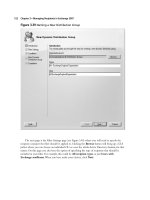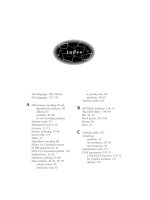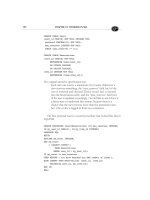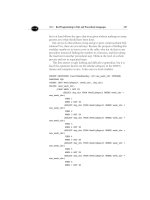SQL PROGRAMMING STYLE- P31 pps
Bạn đang xem bản rút gọn của tài liệu. Xem và tải ngay bản đầy đủ của tài liệu tại đây (156.91 KB, 5 trang )
3.15 Do Not Use Object-Oriented Design for an RDBMS 67
relationship. For them to appear (CREATE TABLE) and disappear
(DROP TABLE) is like living in a world of magic, where a whole new
species of creatures are created by any user, on the fly. Likewise, there
are no OIDs in SQL. GUIDs, auto-numbering, and all of those
proprietary exposed physical locators will not work in the long run.
I have watched people try to force OO models into SQL, and it falls
apart in about a year. Every typo becomes a new attribute, or class
queries that would have been so easy in a relational model are now
multitable monster outer joins, redundancy grows at an exponential
rate, constraints are virtually impossible to write so you can kiss data
integrity goodbye, and so on.
In a thread discussing OO versus relational modeling entitled
“impedance mismatch” in the comp.databases.theory newsgroup in
October 2004, one experienced programmer reported:
I’m here to tell you what you already know—you are 100
percent correct. I am stuck with working with an OO schema
superimposed on an RDBMS. The amount of gymnastics that I
need to go through to do what should be the simplest query is
unimaginable. It took six man-hours (me and one of the OO
developers for three hours) to come up with a query that was
the equivalent of:
SELECT * FROM Field_Offices;
The data needed consisted of basic information, name of the office
location, address, manager, and phone. The final query was almost a full
page long, required the joining of all the various tables for each data
element (as each data element is now an object and each object has its
own attributes, so requires its own table), and of course the monster
object-linking tables so as to obtain the correct instance of each object.
By the way, which instance is the correct one? Why, the latest one, of
course, unless it is marked as not being the one to use, in which case
look for the one that is so marked. And the marking indicator is not
always the same value, as there are several potential values. These object-
linking tables are the biggest in the entire database. Millions of rows in
each of these in just one year’s time to keep track of less than 80,000
entity instances.
Self-joins are needed in some cases; here are two of these monster
tables, and a few smaller ones.
68 CHAPTER 3: DATA DECLARATION LANGUAGE
Fortunately, there are extracts that run nightly to transform the data
into a relational schema set up for reporting, but not all the data is there,
or is wrong, so sometimes I need to go through the above.
3.15.2 Do Not Use EAV Design for an RDBMS
The Entity-Attribute-Value (EAV) design flaw is particularly popular
among newbies who come from the agile or extreme school of software
development. This school used to be called “Code first, design and think
later” when it was first popular.
The idea is that you have one huge table with three columns of
metadata: entity name, attribute name, and attribute value. This lets your
users invent new entities as they use the database. If the American wants
to create something called a “tire” and the British speaker wants to create
something called a “tyre,” then they are both free to do so.
The values have be recorded in the most general data type in the SQL
engine, so you use a lot of VARCHAR(n) columns in the EAV model.
Now try to put a constraint on the column.
Exceptions:
None. There are better tools for collecting free-form data.
CHAPTER
4
Scales and Measurements
B
EFORE
YOU
CAN
put data into a database, you actually need to think about
how it will be represented and manipulated. Most programmers have
never heard of measurement theory or thought about the best way to
represent their data. Although this topic is not specifically about SQL
style, it gives a foundation for decisions that have to be made in the
design of any schema.
4.1 Measurement Theory
Measure all that is measurable and attempt to make measurable that which
is not yet so.
—Galileo (1564–1642)
Measurement theory is a branch of applied mathematics that is useful
in data analysis. Measurements are not the same as the attribute being
measured. Measurement is not just assigning numbers to things or
their attributes so much as it is assigning to things a structural
property that can be expressed in numbers or other computable
symbols. This structure is the scale used to take the measurement; the
numbers or symbols represent units of measure.
Strange as it might seem, measurement theory came from
psychology, not mathematics or computer science. In particular, S. S.
70 CHAPTER 4: SCALES AND MEASUREMENTS
Stevens originated the idea of levels of measurement and classification of
scales. Scales are classified into types by the properties they do or do not
have. The properties with which we are concerned are the following:
1.
A natural origin point on the scale
. This is sometimes called a
zero, but it does not have to be literally a numeric zero. For
example, if the measurement is the distance between objects,
the natural zero is zero meters—you cannot get any closer than
that. If the measurement is the temperature of objects, the
natural zero is zero degrees Kelvin—nothing can get any colder
than absolute zero. However, consider time: It goes from an
eternal past into an eternal future, so you cannot find a natural
origin for it.
2.
Meaningful operations can be performed on the units
. It makes
sense to add weights together to get a new weight. However,
adding names or shoe sizes together is absurd.
3.
A natural ordering of the units
. It makes sense to speak about an
event occurring before or after another event, or a thing being
heavier, longer, or hotter than another thing, but the
alphabetical order imposed on a list of names is arbitrary, not
natural—a foreign language, with different names for the same
objects, would impose another ordering.
4.
A natural metric function on the units
. A metric function has
nothing to do with the metric system of measurements, which
is more properly called SI, for Systemé International d’units in
French. Metric functions have the following three properties:
a. The metric between an object and itself is the natural
origin of the scale. We can write this in a semimathe-
matical notation as
M
(
a
,
a
) = 0.
b. The order of the objects in the metric function does not
matter. Again in the notation,
M(a, b)
=
M(b, a)
.
c. There is a natural additive function that obeys the rule
that
M(a, b)
+
M(b, c)
=
M(a, c)
, which is also known as
the
triangular inequality
.
This notation is meant to be more general than just arithmetic. The
zero in the first property is the origin of the scale, not just a numeric
zero. The third property, defined with a plus and a greater than or equal
4.1 Measurement Theory 71
to sign, is a symbolic way of expressing general ordering relationships.
The greater than or equal to sign refers to a natural ordering on the
attribute being measured. The plus sign refers to a meaningful operation
in regard to that ordering, not just arithmetic addition.
The special case of the third property, where the greater than or equal
to is always greater than, is desirable to people because it means that
they can use numbers for units and do simple arithmetic with the scales.
This is called a
strong metric property
. For example, human perceptions
of sound and light intensity follow a cube root law—that is, if you
double the intensity of light, the perception of the intensity increases by
only 20 percent (Stevens, 1957). The actual formula is “Physical
intensity to the 0.3 power equals perceived intensity” in English.
Knowing this, designers of stereo equipment use controls that work on a
logarithmic scale internally but that show evenly spaced marks on the
control panel of the amplifier.
It is possible to have a scale that has any combination of the metric
properties. For example, instead of measuring the distance between two
places in meters, measure it in units of effort. This is the old Chinese
system, which had uphill and downhill units of distance.
Does this system of distances have the property that
M(a, a)
= 0? Yes. It
takes no effort to get to where you already are located. Does it have the
property that
M(a, b)
=
M(b, a)
? No. It takes less effort to go downhill than
to go uphill. Does it have the property that
M(a, b)
+
M(b, c)
=
M(a, c)
?
Yes. The amount of effort needed to go directly to a place will always be
less than the effort of making another stop along the way.
4.1.1 Range and Granularity
Range and granularity are properties of the way the measurements are
made. Because we have to store data in a database within certain limits,
these properties are important to a database designer. The types of scales
are unrelated to whether you use discrete or continuous variables.
Although measurements are always discrete because of finite precision,
attributes can be conceptually either discrete or continuous regardless of
measurement level. Temperature is usually regarded as a continuous
attribute, so temperature measurement to the nearest degree Kelvin is a
ratio-level measurement of a continuous attribute. However, quantum
mechanics holds that the universe is fundamentally discrete, so
temperature may actually be a discrete attribute. In ordinal scales for
continuous attributes, ties are impossible (or have probability zero). In
ordinal scales for discrete attributes, ties are possible. Nominal scales









